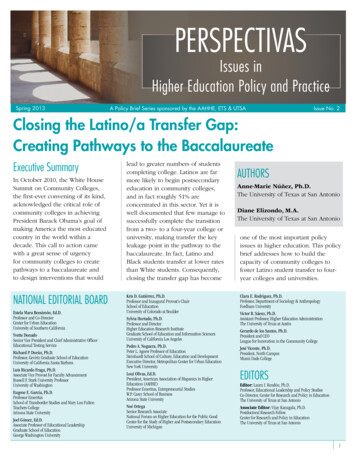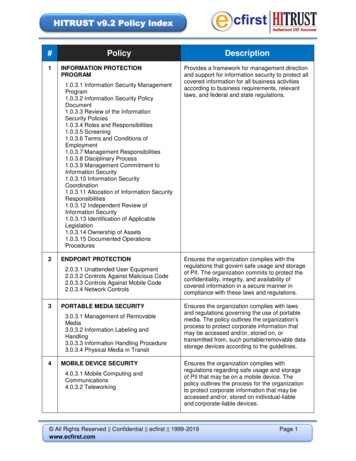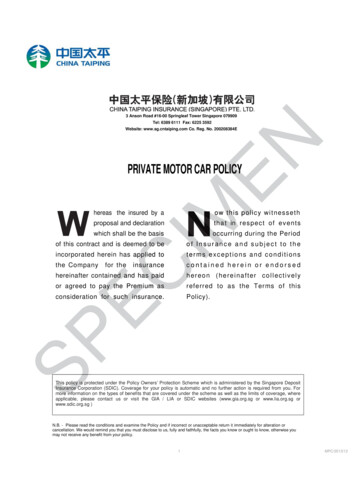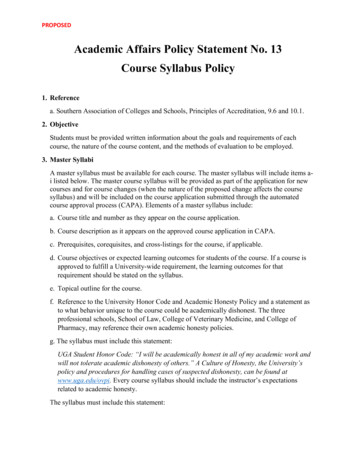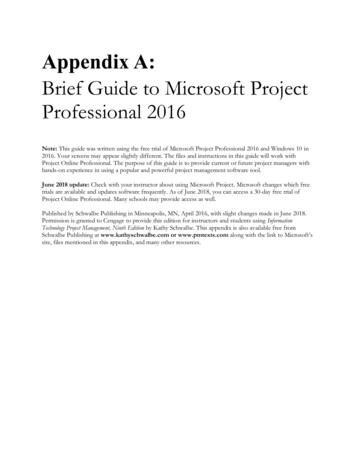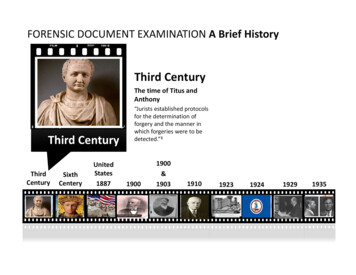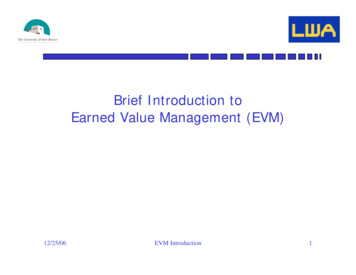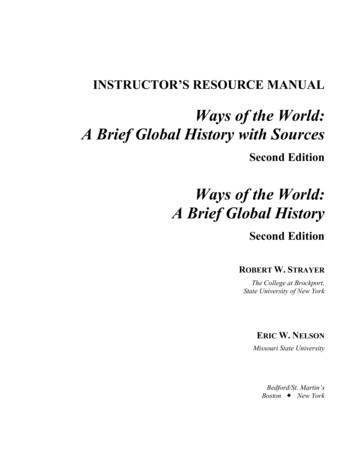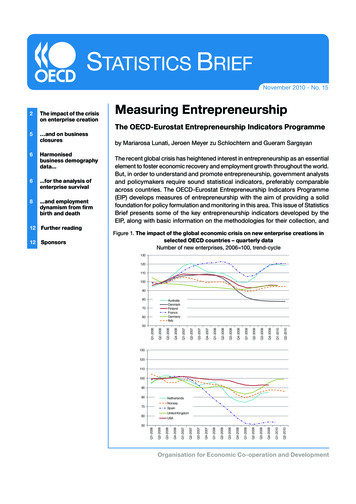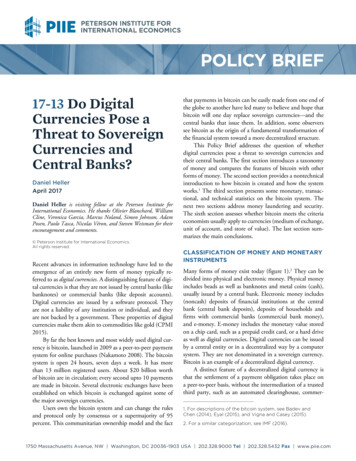
Transcription
POLICY BRIEF17-13 Do DigitalCurrencies Pose aThreat to SovereignCurrencies andCentral Banks?Daniel HellerApril 2017Daniel Heller is visiting fellow at the Peterson Institute forInternational Economics. He thanks Olivier Blanchard, WilliamCline, Veronica Garcia, Marcus Noland, Simon Johnson, AdamPosen, Paolo Tasca, Nicolas Véron, and Steven Weisman for theirencouragement and comments. Peterson Institute for International Economics.All rights reserved.Recent advances in information technology have led to theemergence of an entirely new form of money typically referred to as digital currencies. A distinguishing feature of digital currencies is that they are not issued by central banks (likebanknotes) or commercial banks (like deposit accounts).Digital currencies are issued by a software protocol. Theyare not a liability of any institution or individual, and theyare not backed by a government. These properties of digitalcurrencies make them akin to commodities like gold (CPMI2015).By far the best known and most widely used digital currency is bitcoin, launched in 2009 as a peer-to-peer paymentsystem for online purchases (Nakamoto 2008). The bitcoinsystem is open 24 hours, seven days a week. It has morethan 13 million registered users. About 20 billion worthof bitcoin are in circulation; every second upto 10 paymentsare made in bitcoin. Several electronic exchanges have beenestablished on which bitcoin is exchanged against some ofthe major sovereign currencies.Users own the bitcoin system and can change the rulesand protocol only by consensus or a supermajority of 95percent. This communitarian ownership model and the factthat payments in bitcoin can be easily made from one end ofthe globe to another have led many to believe and hope thatbitcoin will one day replace sovereign currencies—and thecentral banks that issue them. In addition, some observerssee bitcoin as the origin of a fundamental transformation ofthe financial system toward a more decentralized structure.This Policy Brief addresses the question of whetherdigital currencies pose a threat to sovereign currencies andtheir central banks. The first section introduces a taxonomyof money and compares the features of bitcoin with otherforms of money. The second section provides a nontechnicalintroduction to how bitcoin is created and how the systemworks.1 The third section presents some monetary, transactional, and technical statistics on the bitcoin system. Thenext two sections address money laundering and security.The sixth section assesses whether bitcoin meets the criteriaeconomists usually apply to currencies (medium of exchange,unit of account, and store of value). The last section summarizes the main conclusions.CLASSIFICATION OF MONEY AND MONETARYINSTRUMENTSMany forms of money exist today (figure 1).2 They can bedivided into physical and electronic money. Physical moneyincludes beads as well as banknotes and metal coins (cash),usually issued by a central bank. Electronic money includes(noncash) deposits of financial institutions at the centralbank (central bank deposits), deposits of households andfirms with commercial banks (commercial bank money),and e-money. E-money includes the monetary value storedon a chip card, such as a prepaid credit card, or a hard driveas well as digital currencies. Digital currencies can be issuedby a central entity or in a decentralized way by a computersystem. They are not denominated in a sovereign currency.Bitcoin is an example of a decentralized digital currency.A distinct feature of a decentralized digital currency isthat the settlement of a payment obligation takes place ona peer-to-peer basis, without the intermediation of a trustedthird party, such as an automated clearinghouse, commer1. For descriptions of the bitcoin system, see Badev andChen (2014), Eyal (2015), and Vigna and Casey (2015).2. For a similar categorization, see IMF (2016).1750 Massachusetts Avenue, NW Washington, DC 20036-1903 USA 202.328.9000 Tel 202.328.5432 Fax www.piie.com
April 2017MonthPB17-13Number PB17-xxFigure 1 Taxonomy of moneyPhysicalElectronicMoney in the traditional sense (denominatedin a sovereign currency)Central bank moneyPhysical tokens (beads, shells);privately issued notesCash (notesand coins)Commercialbank moneyCentral bankdepositsPeer-to-peer settlementE-money (broad sense)Legallyrecognizede-money(e-moneyin thenarrow sense)Digital currenciesCentrallyissuedCentralized settlement (trusted third party)Decentralizedor automaticissuancePeer-to-peersettlementSource: Based on CPMI (2015).cial bank, or central bank. This property is very similar tobanknotes and metal coins. In fact, bitcoin founder Nakamoto (2008) claims that bitcoin transactions are as secureas settlement in bank notes and that no other “mechanismexists to make payments over a communications channelwithout a trusted third party.”3established. Both private- and public-sector-issued notes werein circulation for about 20 years thereafter (Weber 2015).Modern Electronic Payment and SettlementModern electronic payment and settlement processes arehighly centralized and intermediated. Central banks issuesovereign currencies (fiat money) and provide settlementservices, commercial banks specialize in taking deposits andmaking loans, central securities depositories electronicallystore securities, and central counterparties clear derivatives.This specialization is based on the existence of increasingreturns to scale (Baltensperger 1980, Diamond 1984). Anessential element for these intermediaries to assume their roleand enhance the efficiency of the economy is that marketparticipants trust them.Figure 2 reveals the high degree of centralization and intermediation using the example of a recurring retail paymentfrom a household (payer) to a merchant (payee). The payersends a payment instruction to the bank where she holds achecking account (Bank 1). The bank authenticates the payerand checks whether she has enough funds in her account. Ifshe does, the bank forwards the payment instruction to anautomated clearinghouse, which aggregates and nets out thepayment amounts it receives from participating banks.At certain intervals—for instance, every two hours—theautomated clearinghouse sends payment instructions for thenet positions to the central bank for settlement (transfer ofdeposit balances). As soon as the central bank transfers thenet debit balances of the participating bank, the payment isfinal (unconditional and irrevocable). Bank 2 then creditsthe account of the payee. The entire payment process usually lasts several hours, although it can take more than a day,depending on the payments infrastructure of a country.4 ForHistory of Paper Money and DepositsThe history of money is full of examples in which the privatesector came up with innovations that successfully challengedthe monopoly of the sovereign to issue money. The first papermoney was issued by the private sector in the 10th centuryin China. It competed with copper coins of uncertain quality(Bernholz 2003). It took until the 17th century before papermoney was introduced in Europe (Sweden), although privatedeposit accounts appeared in Northern Italy in the 12th century (Ferguson 2008). Many city-states and dukes had beenissuing their own coins, often of poor and unknown quality,hindering trade and commerce in the region. Against thisbackground, private money exchangers introduced depositaccounts against high-quality coins. These deposit accountswere then used to transfer money between clients as bookentries, without the use of coins. Modern banking was bornwhen these money exchangers also started providing loans.In the 19th century, sovereign states frequently delegated the issuance of paper money to private-sector banks.In Canada, for instance, private banks began issuing notes in1817—almost 50 years before provincial governments didso. The simultaneous circulation of private and governmentnotes ended in Canada only in 1950 (Fung, Hendry, andWeber 2017). In the United States, only private banks issuedbank notes until 1913, when the Federal Reserve System was4. The process for large-value interbank payments is muchfaster. Interbank payments typically settle without delayand are immediately final. The processing speed of retailpayments has increased markedly in recent years. In manycountries retail payment systems provide immediate realtime finality (CPMI 2016a; Bech, Shimizu, and Wong 2017).3. The identity of Satoshi Nakamoto is a mystery as it is stillnot known which person or group hides behind this pseudoym. After frequent forum posts and exchanges of emails,Nakamoto vanished in 2011, saying that he or she “moved onto other things.”21
April 2017Number PB17-13Figure 2 Traditional payment process with intermediationPayerPayeeAutomatedclearinghouseBank 1Bank 2Central bankcross-border payments, the process is even more complexand more time consuming, as it is likely to involve correspondent banks.poses a complex cryptographic puzzle to the community ofminers. The miner who is the first to solve this puzzle winsthe right to generate the next block. A miner can influenceher chances of being the first to solve this puzzle by increasing the amount of computational power she dedicates to thetask. The winning miner receives a reward in the form ofnewly issued bitcoin, known as the coinbase. The market formining is open to anyone with the required hardware andsoftware. In recent years, high-speed processors have beendeveloped especially for bitcoin mining. They can be purchased on the internet. The software is open source and canbe downloaded for free.Vigna and Casey (2015) compare this competitionamong miners with participation in a lottery. The more tickets people buy, the higher their chances of winning. But noparticipant can ever be certain to win. Because new blocksare created every 10 minutes, miners can estimate their probability of wining and determine the expected value of winning a reward.Once the system has determined the winning miner, theother miners assess whether the block propagated by the winner is valid. This validation is necessary to prevent fraud inthe network. In particular, it is a means to prevent the samebitcoin (or a fraction of it) from being spent twice (so-calleddouble spending). Miners provide trust in the system byserving as independent validators or notaries. If the majorityTRANSACTIONS IN THE BITCOIN SYSTEMPayments in bitcoin take place without the intermediationof automated clearinghouses, commercial banks, or centralbanks. Figure 3 shows the settlement process. The process isinitiated by the payer, who sends a payment instruction overthe internet to participants in the bitcoin network, includingthe payee and “miners,” who act as validators and recordkeepers of all bitcoin transactions.Transaction data are stored in electronic files calledblocks. The entire history of transactions is recorded in along sequence of blocks called a blockchain.5 Every 10 minutes the bitcoin network packages the latest transactions intoa new electronic block.6 The right to create the next blockthat is added to the blockchain is assigned to only one miner.In order to determine which miner this will be, the system5. A blockchain is a type of distributed ledger, comprisingunchangeable, digitally recorded data in packages or blocks.Each block is then “chained” to the next block, using a cryptographic signature.6. Since the inception of the bitcoin system in 2009, morethan 460,000 blocks have been created.3
April 2017Number PB17-13Figure 3Peer-to-peer settlement in bitcoinPayeePayerMiner 1Miner 3Miner 2Miner 4Public distributed ledgerSOME STATISTICS ON BITCOINof miners (in terms of their computational power) agree thatthe transactions in a block are valid, identical copies of theblock are distributed through the network, where they arestored in a decentralized way on the miners’ computers.It takes about an hour until the transactions of a blockare considered final. This delay makes bitcoin unsuitablefor large-value interbank payments, as the current real-timegross settlement systems eliminate settlement risk by providing immediate finality of payments.Bitcoin is the first modern application of “distributedledger” technology, a collective term that contains severalcomponents, including the use of blockchains, public keyinfrastructure, cryptographic signing, and hash functions,among others.7 While the particular components requiredvary according to the problem being solved, in all distributed ledger applications a record of transactions or otherdata is stored across multiple entities (i.e., it is distributed)in a network, making the distributed ledger “a common, authoritative prime record—a single source of truth—to whichmultiple entities can refer and with which they can securelyinteract” (Digital Assets Holdings 2016).8Every 10 minutes the bitcoin system issues new bitcoin ascompensation for miners. The rate of bitcoin issuance is predetermined and exogenously given. Bitcoin “printing” decelerates over time, as issuance is cut by half every four years.The next time the block mining reward halves is in June2020. The bitcoin reward per block will then decrease from12.5 to 6.25. With the current block reward, the numberof bitcoin in circulation increases by about 2 percent a year.In addition, there is an upper limit of BTC21 millionthat can ever be generated. More than half of the lifetimesupply of bitcoin was created in the first six years (figure 4).So far about 75 percent of the maximum number of bitcoinhas been issued; about BTC5 million is left. The ceiling willbe reached within 20 years.In its early years, bitcoin traded below 1 (figure 5). InDecember 2013, the value of the bitcoin reached 1,150.In 2014 it depreciated to a low of 200. In March 2017 itappreciated to an all-time peak of 1,285. Since then, theprice has oscillated between 940 and 1,200. According tothe International Monetary Fund (IMF 2016), the pric
sends a payment instruction to the bank where she holds a checking account (Bank 1). The bank authenticates the payer and checks whether she has enough funds in her account. If she does, the bank forwards the payment instruction to an automated clearinghouse, which aggregates and nets out the payment amounts it receives from participating banks.

